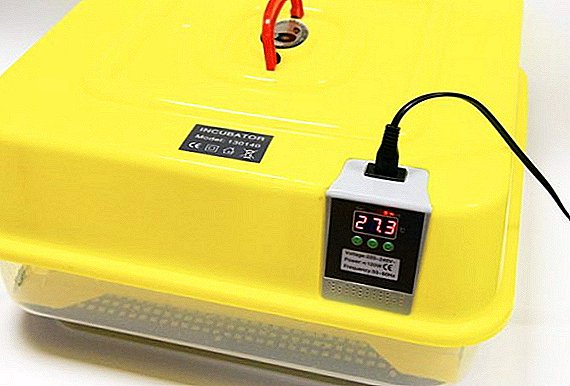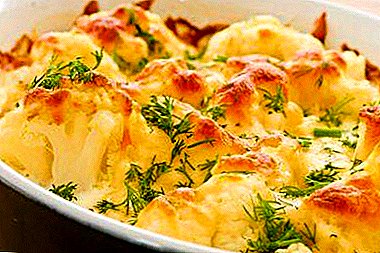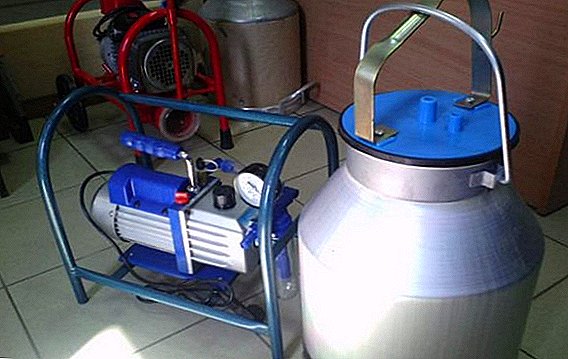 Each large and small livestock farm needs modern auxiliary equipment, one of which is traditionally considered to be a milking machine. However, not all herders can boast enough funds to buy modern models of equipment.
Each large and small livestock farm needs modern auxiliary equipment, one of which is traditionally considered to be a milking machine. However, not all herders can boast enough funds to buy modern models of equipment.
In this case, many have resorted to the independent production of all the necessary things from improvised means.
In this article we will examine in detail the basic principles and subtleties of the design of the milking machine with our own hands, and also share the secrets of choosing high-quality components.
How does the milking machine
The milking machine is an automated device for extracting milk from the udder of a cow. Such installations operate on the principle of vacuum retraction. After connecting the tip to the udder (teat cup), it artificially creates conditions of rarefied atmospheric pressure.  As a result of this, the milk, under the influence of the pressure difference, is gravity ejected outside.
As a result of this, the milk, under the influence of the pressure difference, is gravity ejected outside.
In the operation of such a unit, several cycles are provided, among them there are:
- two-stroke milking machines - devices that operate on the principle of cyclic retraction and a short rest or retraction and compression. In the first case, a vacuum is created in the cavity between the teat cup and the udder, through which the milk is drawn out. When a certain portion of milk enters the machine, the pressure difference decreases and the milking stops, while maintaining the vacuum conditions in the glass. In the second case, after a vacuum suction stroke in the teat cup, the internal and atmospheric pressure levels off;
- three-stroke milking machines - devices operating on the principle of cycling the processes of inhaling, compression and rest. After connecting the device to the udder, a vacuum is created between the teat cup and the udder, through which the milk is drawn out. Next comes the reduction of pressure, after which the third stroke starts - rest (leveling the atmospheric pressure with the internal pressure of the teat Cup).
Did you know? The first vacuum milking machine was created in 1859 by innovator herder John Kingman.
The most preferred in modern cattle breeding are three-stroke models. With their help, it is possible to remove all the milk gently and practically without harm to the udder. However, the main disadvantage of such milking systems is the high cost, as well as more complex maintenance compared to the two-stroke.
How to make a milking machine with your own hands
Despite the complexity of automated milking and the relatively high specificity of the process, the equipment itself is not technically complex. That is why many people resort to self-manufacturing of devices from improvised means and components from a nearby hardware store.  But in order to create a truly sound and high-quality device, you must first deal with its main components and the main features of the assembly.
But in order to create a truly sound and high-quality device, you must first deal with its main components and the main features of the assembly.
Design
Before installing the final design, each farmer must carefully design all the nodes of the device, possible ways to mount them and other features of the device. For these purposes, you need to understand in detail the basic design features of the most popular factory models.
Modern milking systems consist of the following technical units:
- vacuum type electric pump;
- milking complex;
- power plant (mechanical, electric or manual type).
In turn, the milking complex includes:
- Vacuum pump;
- pulsator;
- hanging knot;
- tank for collecting milk;
- connecting hoses for the pump;
- hoses-lines for the transport of milk.
Did you know? For dairy products, the cow first began to be used about 9 thousand years ago, so it is one of the oldest animals used for agricultural purposes.
It should be noted that such a device entirely out of improvised means cannot be created, since not many of us can boast with an abundance of various specific details.  Even in the presence of a high-precision lathe, in most cases, domestic production will not allow high-quality manufacturing of the necessary elements of the engine and other systems. That is why the most optimal option is considered to be an independent assembly of the milking plant from the factory nodes.
Even in the presence of a high-precision lathe, in most cases, domestic production will not allow high-quality manufacturing of the necessary elements of the engine and other systems. That is why the most optimal option is considered to be an independent assembly of the milking plant from the factory nodes.
Selection of basic components
Selection of components - this is one of the main stages of creating a homemade milking machine. During this period, you should carefully deal with all the features of a particular equipment, since not only the effectiveness of the future device, but also its durability depends on it.
In addition, this stage is decisive for many, since it is in the selection of spare parts that it is possible to reveal the feasibility and main financial benefits of a homemade milking machine.
Find out if milking machines are so good, and also, get acquainted with the technical characteristics of such a milking machine as AID 2.
Pumps and motors
The pump system and motor are the heart of the milking system. The success of the entire milking process of milk depends on their efficient, high-quality work. On the market there are a huge number of various models of pumps and the corresponding engines of both domestic production and foreign.
When choosing these units should, first of all, pay attention to the modern and time-tested manufacturers. At the same time, it is necessary to dwell on models of not less than average price policy, they stand out favorably with a good price-quality ratio, as well as inexpensive in post-warranty service.  Careful attention should be paid to the power and energy consumption of the pump and engine. For small farms, powerful milking machines are not appropriate, as they do not justify the final energy costs. If there are no more than two cows on the farm, equipment with a capacity of about 0.5 kW will be the most optimal.
Careful attention should be paid to the power and energy consumption of the pump and engine. For small farms, powerful milking machines are not appropriate, as they do not justify the final energy costs. If there are no more than two cows on the farm, equipment with a capacity of about 0.5 kW will be the most optimal.
More powerful systems of 4 kW or more are excellent for themselves on medium-sized farms when servicing more than 10 animals at a time.
Functionally, pumps are of two types - vacuum and oil. Oil pumps are not preferred for milking installations. They create an excessive amount of noise, and also require constant adjustment of the oil level in the system.
In addition, in such pumps, over time, the tightness of the oil tank is lost, which can compromise the sterility and cleanliness of the entire system. Unlike oil, the vacuum pump is almost silent, unpretentious in work and maintenance.
Did you know? Before the appearance of milking machines in the second half of XIX, special tubes-catheters were inserted into the udder to automate the milking process to cows, allowing milk to be removed by gravity. However, this procedure often ended with animal mastitis.
Hanging knot
Suspension assembly - this is the part of the milking machine, which is not worth saving. This site contains several spare parts that are in direct contact with animals, so cheap parts can not only cause discomfort to the cow, but also harm.  In this case, you should pay your attention solely to manufacturers who have proven themselves in the market. And for this you need to carefully examine all existing reviews on the network.
In this case, you should pay your attention solely to manufacturers who have proven themselves in the market. And for this you need to carefully examine all existing reviews on the network.
In addition, when choosing elements of the suspension node, you must pay attention to:
- color of teat cups - they should be transparent, it will help to visually monitor the process of extracting milk from the udder;
- rubber quality - all rubber elements of the suspension unit must be made of high-quality and non-toxic materials;
- fasteners glasses - the glasses should be fixed with the help of soft silicone suction cups, this will allow to extract the maximum amount of milk with the minimum power of the engine and pumping system.
Find out also how to milk a cow correctly and how many times.
Pulsators and collectors
The choice of pulsators and collectors is a matter of personal preference, so when choosing these items you should use the recommendations of the sellers in the store and personal experience. On the market there are models of foreign and domestic production.
Overseas are characterized by increased wear resistance, while domestic ones are low cost and easy to maintain, therefore, they often use their own preferences in this matter, as well as the size of the budget.
In addition, there are both separate devices on the market, as well as two-in-one type of puls collectors. The most cheap, simple to install and maintain are the pulsocollectors.  They have all the necessary technical requirements, as well as a soft and smooth working stroke, which is not achieved when installing a separate pulsator and collector. As a result of this, with the help of a pulsed collector, it is possible to bring artificial extraction of milk closer to natural milking.
They have all the necessary technical requirements, as well as a soft and smooth working stroke, which is not achieved when installing a separate pulsator and collector. As a result of this, with the help of a pulsed collector, it is possible to bring artificial extraction of milk closer to natural milking.
Well, this, in turn, has a positive effect on the quality indicators of milk, and also helps reduce the chances of a cow getting sick with mastitis.
Important! When milking a cow, it is necessary to strictly follow all existing rules of hygiene, otherwise the procedure may have a detrimental effect on the health of the animal.
Additional elements
Additional elements of the milking machine often include the primary tank for milk, as well as connecting hoses and main hoses. It is necessary to approach the choice of hoses strictly.
According to them, the milk should be transported to the primary container, so they must be made of durable, wear-resistant, but at the same time non-toxic materials. Otherwise, a part of toxic substances can easily accumulate in the milk, and this is a direct way to the rejection of all products.
Primary containers for milk accumulation are chosen based on personal preferences and financial possibilities. Such containers are plastic or metal (stainless steel or aluminum).  Each of the materials has its advantages and disadvantages:
Each of the materials has its advantages and disadvantages:
- aluminum containers are distinguished by minimum weight and durability, however, over time, the metal will oxidize, leading to the accumulation of aluminum oxides in milk;
- Stainless steel is practically inert to any aggressive media and is highly durable, but such containers are often inconvenient due to their excessive weight;
- Food grade plastic is light and practically inert to any food, but over time it cracks and collapses under mechanical stress.
Assembly
The main stages of the assembly of the home milking machine:
- Secure the pump and the engine to the sturdy bearing with a bolt connection.
- Adjust the gear between the pump and the motor.
- Build a protective screen of plywood or sheet metal around the pump and engine to protect them from excessive dirt and dust.
- Attach rubber hoses of the required length to the pump; milk will be transported through it to the primary container.
- Connect the pulse collector to the hose.
- Connect the pendant unit to the pulsator.
- Make a hole in the lid of the milk collection tank and install a check valve into it, this is necessary to adjust the pressure during milking.
Important! The hoses on the milking machine should not be excessively short, as this will adversely affect the usability of the device. The most optimal are highways with a length of about 2 meters.
Homemade or Purchased
Before thoroughly spending on the purchase of components for the milking machine, it is necessary to evaluate all the pros and cons of such a device, as well as its feasibility. Independent production of equipment is not always advisable to purchase ready-made devices.  This issue is particularly acute in the event that the final assembly will require expenditures on additional components, as well as the work of a specialist.
This issue is particularly acute in the event that the final assembly will require expenditures on additional components, as well as the work of a specialist.
The main advantages of the homemade milking machine:
- low cost of the unit (for self-assembly);
- the ability to create equipment for themselves, on an individual project;
- the system is completed on the basis of personal needs and requirements;
- the device can be serviced independently.
Find out what are the ways of processing and the types of cow's milk, as well as what it is useful and harmful.
The disadvantages of homemade milking machine:
- no guarantee for the quality of the system assembly;
- installation of the system requires additional knowledge and skills;
- low efficiency of final costs (at the cost of the work of an assembly specialist);
- installation of individual components requires individual technical solutions.
The main advantages of factory milking machines:
- full warranty of the device is confirmed by the relevant certificates;
- manufacturer's warranty for the smooth operation of the system;
- the device is completely ready for operation;
- elegance and aesthetic design.
 The main disadvantages of factory milking machines:
The main disadvantages of factory milking machines:- high price;
- technical solutions of the device do not take into account the individual needs of consumers;
- service often requires calling a specialist from an official service center;
- expensive post-warranty repair and maintenance.
Important! Before using the device of animals, it is necessary to prepare for its noise; for this purpose, the installation for several days periodically includes 10-15 minutes. Otherwise, the cow may dramatically negatively respond to mechanical milking.
The milking machine is an important and necessary device for any modern cattle farm. It makes it possible to reduce the total labor costs of the farm, as well as to establish an uninterrupted milk production process.
Its design is quite simple, which allows you to create a device even with your own hands. But in order for such a device to meet all modern technical requirements, you need to strictly approach not only the choice of components, but also the assembly of the system.












